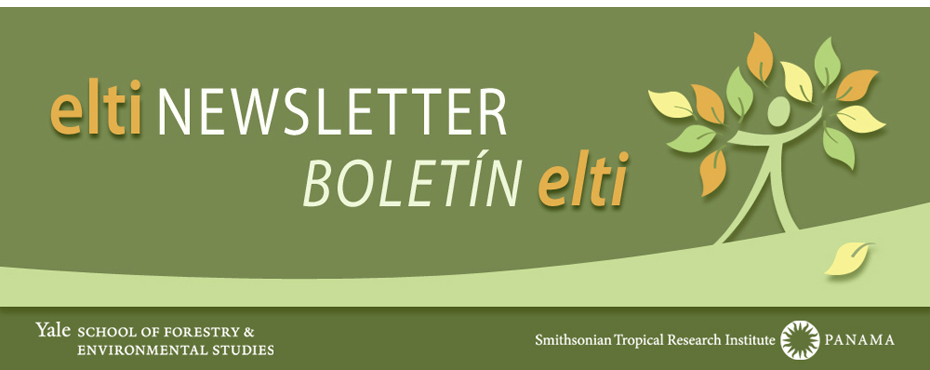practice of replacing natural vegetation, such as forests, with grass monocultures has been one of the primary drivers of deforestation and biodiversity loss throughout the tropics.
The tides are changing, however, as new generations of cattle ranchers begin to understand and recognize the value of biodiversity in their fields. The establishment of agroforestry and silvopastoral systems (SPS), for example, which incorporate trees and their associated fauna with cattle production, has proven to generate better yields in terms of meat and milk as well as key ecosystem services. The fact that cattle and trees can coexist has been the basis for two events that ELTI and its partners, the Center for Research on Sustainable Agricultural Production Systems (CIPAV) and the Ecological Restoration Lab (LERF) of the University of Sao Paulo, Brazil, have developed in Quindío, Colombia.
ELTI, CIPAV and LERF have trained 26 technicians from five regions in Colombia, and five from other parts of Latin America (Panama, Peru, Brazil and Guatemala), on the establishment of connectivity corridors by combining a variety of SPS with native tree reforestation of degraded areas and riparian corridors. During the first course (May 2011), participants learned technical tools and strategies to establish corridors. In this second course, participants explored a variety of strategies to ensure the sustainability of their efforts, including payment-for-ecosystem services programs, multi-modal tourism schemes, the design and management of tree nurseries, the establishment of seed collectors’ networks, transfer of seed banks, and restoration models with commercial value.
At the end of the first course, participants were asked to develop preliminary plans for the development of connectivity corridors in their regions of work. During this second course, all participants presented their plans and received expert feedback from the instructors. Participants have now gone back to their regions and countries and have begun to implement their projects. We look forward to reporting on their efforts to restore connectivity corridors for biodiversity and the generation of ecosystems services throughout Colombia and Latin America.
More about this event
........................................................................................................................
Estrategias de Sostenibilidad para los Corredores de Conectividad
La ganadería no es sólo una actividad económica, pero también un estilo de vida. La mayoría de los ganaderos tradicionales se incomodan con la idea de sembrar árboles y arbustos en sus pasturas, quitándole espacio al pasto mejorado. Esto tiende a ser una “norma cultural” de la industria, donde la práctica de reemplazar vegetación natural como bosques, con monocultivos de pasto ha sido uno de los principales motores de la deforestación y pérdida de biodiversidad a lo largo del trópico.
Sin embargo, los tiempos van cambiando y existe una nueva generación de ganaderos que han comenzado a comprender y reconocer el valor de la biodiversidad en sus pasturas. El establecimiento de sistemas agroforestales y silvopastoriles (SSP), que incorporan árboles y su fauna asociada a la producción ganadera, han mostrado que pueden generar mayores rendimiento de carne y leche y generar servicios ambientales fundamentales. El ganado y los árboles pueden coexistir, y ésta ha sido la base para el desarrollo de dos eventos de capacitación en el Quindío, Colombia por parte de ELTI y sus aliados, el Centro de Investigación en Sistemas Sostenibles de Producción Agropecuaria (CIPAV) y el Laboratorio de Restauración Ecológica (LERF) de la Universidad de Sao Paulo, Brasil.
ELTI, CIPAV y LERF han capacitado a 26 técnicos de cinco regiones de Colombia, y a cinco más de otras partes de América Latina (Panamá, Perú, Brasil, Guatemala), en el establecimiento de corredores de conectividad utilizando sistema silvopastoriles intensivos y reforestando áreas degradadas y corredores ribereños con especies nativas. Durante el primer curso (mayo de 2011), los participantes aprendieron herramientas técnicas y estrategias para establecer los corredores. En este segundo curso, los participantes exploraron una variedad de estrategias para garantizar la sostenibilidad de sus esfuerzos, incluyendo programas de pagos-por-servicios ambientales, esquemas de turismo multimodal, el diseño y manejo de viveros, la logísitca de la recolección de semillas, la transferencia de bancos de semillas, y modelos de restauración con fines comerciales.
Al concluir el primer curso, los participantes debían desarrollar planes preliminares para el desarrollo de corredores de conectividad en sus regiones de trabajo. Durante este segundo curso, todos los participantes presentaron sus planes y recibieron realimentación de los instructores y otros expertos. De regreso a sus regiones y países, los participantes han iniciado la ejecución de sus proyectos. Les estaremos informando acerca de los esfuerzos de este grupo de restaurar corredores de conectividad para la biodiversidad y generación de servicios ambientales en Colombia y América Latina.
Más sobre este evento
Más sobre este evento


No comments:
Post a Comment